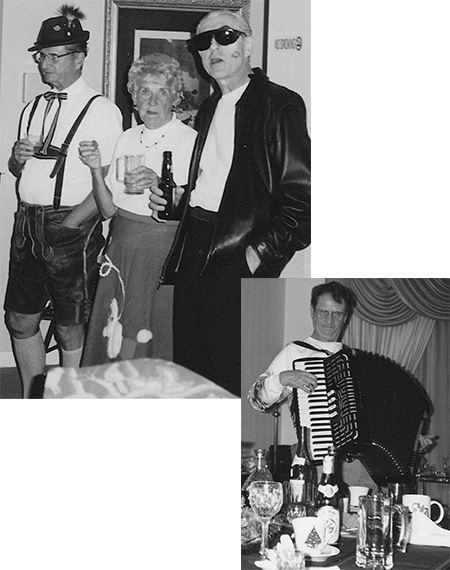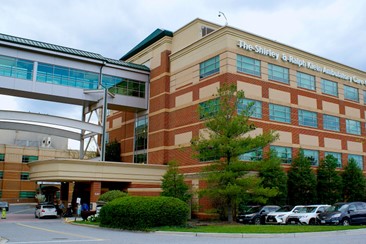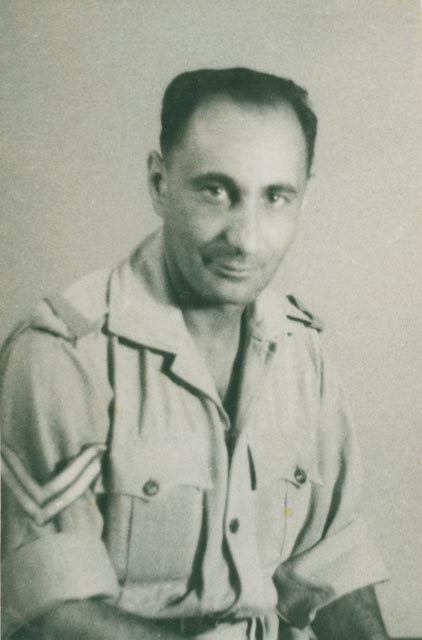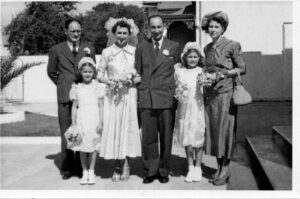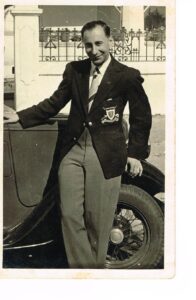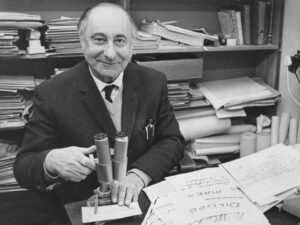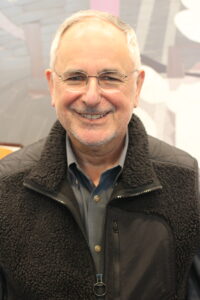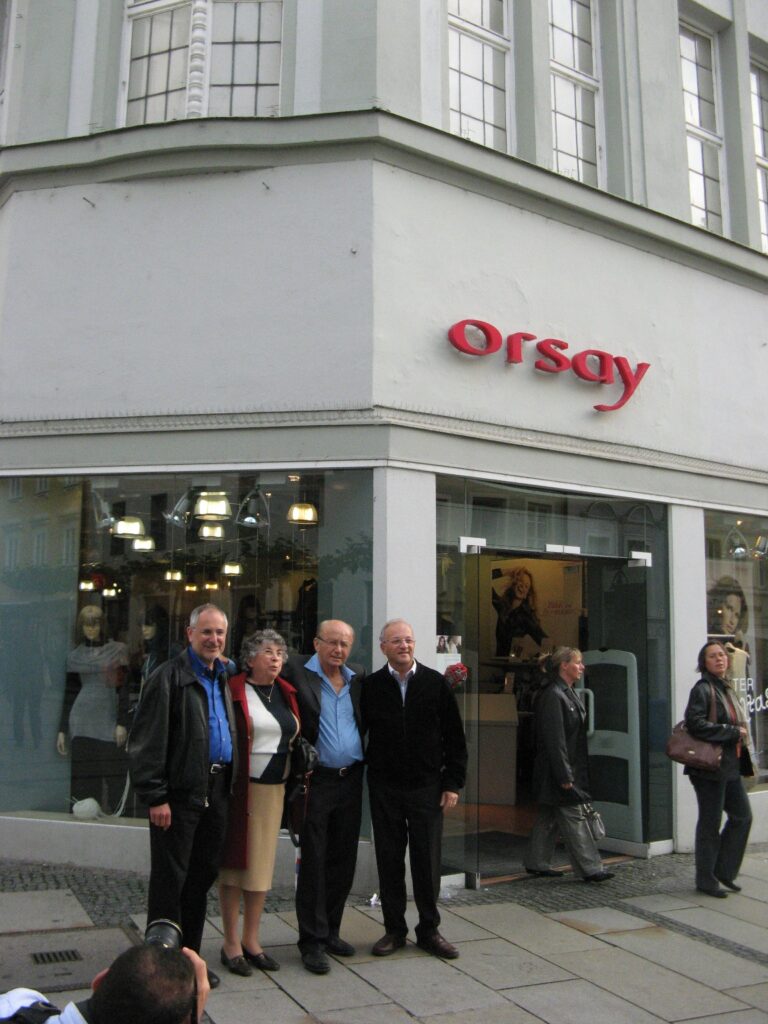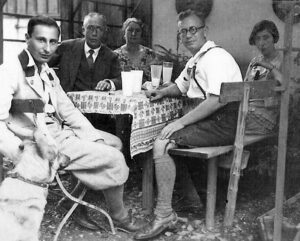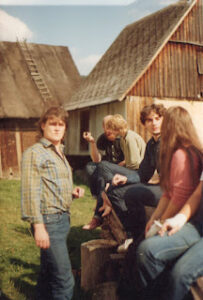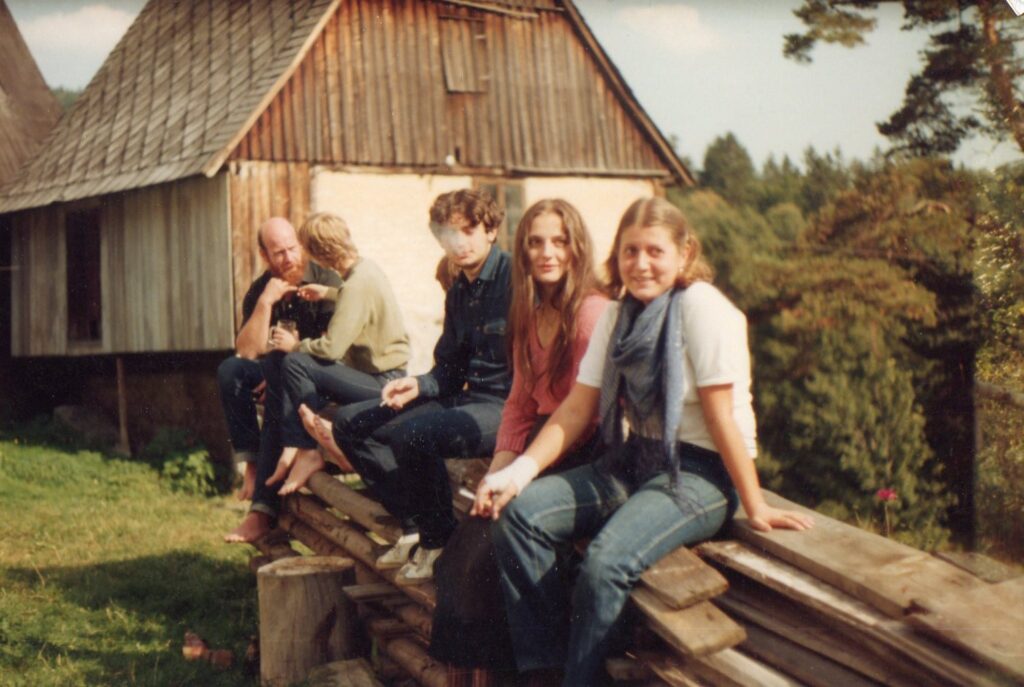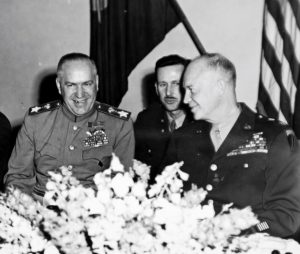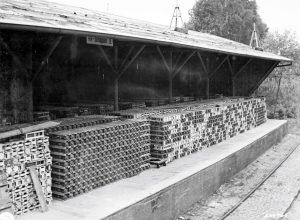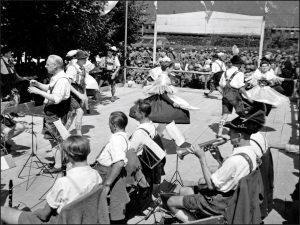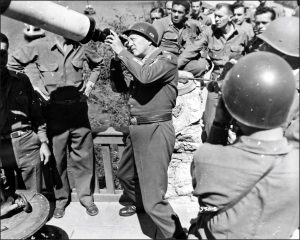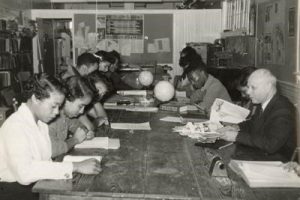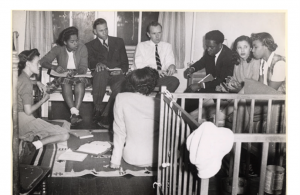Sep 15 2024
Baltimore: German and German-Jewish Populations Expand the City (Pt. 3)
by Anna Rosmus
Anna Rosmus uses archival material and interviews to tell the story of German and German-Jewish heritage in the greater Baltimore area. Quotes without citations are from her conversations and correspondence. This is the third and final post in a three-part series. Click here for “Baltimore: German and German-Jewish Populations Expand the City (Pt. 1)” and “Baltimore: German and German-Jewish Populations Expand the City (Pt. 2)”
Bel Air
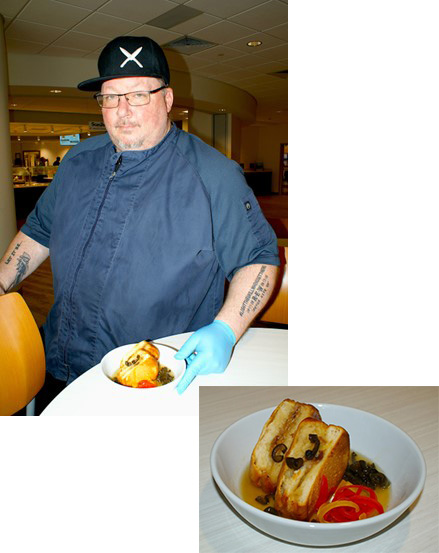
Michael Wagner presenting a bowl in the Bel Air hospital cafeteria
Having grown up in Ocean City, MD, the 45-year-old with German-Irish ancestors considered himself “a hard-core alcoholic, and a drug addict.” That cost him his driver’s license. When Wagner was told he may just have another three years to live before dying of liver cirrhosis, he looked for a fresh start where he could continue to cook – albeit without alcohol. In 2022, after a few months at Panera, he was hired at the Bel Air hospital. Food for patients, often on dull diets, was a challenge. Nonetheless, Wagner hoped to include at least some excitement. Plates he served often had a decidedly different look. Preparing meals for staff members and visitors gave him more options. Although most recipes still came from an outside vendor, Wagner was free to insert slight variations, and coworkers were not the only ones who noticed these differences. Whereas his juicy meatloaf quickly sold out, another colleague’s look-alike version was mocked as mere cardboard and “sawdust.” Prompted how he achieved his cooking skills, Wagner recalled:
My parents used to frequent a bar. Chef Kevin King was tired of me sitting in a booth, waiting for them. When I was 12 [years old], he pulled me to the kitchen. I’ve loved cooking ever since. Later on, I attended culinary school where I learned the ins-and-outs of paying for all that.
Today, Wagner feels integrated in his new neighborhood. He is planning to buy the house he is now renting, and once he gets his driver’s license back, he might aim for a position as a traveling sous chef. If he could change anything, Wagner said, it would be “more positivity, all around.”
Asked what it is like to have him in the dietary department, its director admitted: “Very humbling; especially since I liked cooking since I was a teenager. It makes me realize how much I don’t know sometimes.”
In a multi-facetted crowd like UMUCH employees, national and racial stereotypes were often subjects of discussion and some banter. Laura Vrettakos, who married the son of Greek immigrants, could easily blend into any Bavarian crowd. During a break in the cafeteria, she told other food service workers how irritated she was as a teenager, when her father and her stepfather showed her the cold shoulder when she did not voluntarily hand over $25 from her first job.
After a car accident, Vrettakos explained, her mother was disabled, and Robert Maurer, her father, did shift work. For years, four of the five teenaged children already held jobs. To help with the family’s grocery bills, each one was expected to contribute $25 a week. That way, they also learned about “responsibility,” a key word of their youth. “That and the silence may be a German thing,” Vrettakos speculated. “I’d rather had them shout at me, and we could get it all out instead. But they were stubborn.” Maurer was born here, but his mother and father had immigrated from Munich. Francis Pfarr, her stepfather, had a maternal grandmother from Germany.
Donna Kelble, who joined the dietary department six years ago, was eager to confirm that. Snickering, she explained, “My husband is German. Extremely smart and focused, but also stubborn. He’s an engineer with two degrees. He takes charge. Yesterday, we went to a German restaurant. I had pork, very thinly sliced, and breaded. It was really good.” “Schnitzel,” one of the cooks commented before Kelble could add, “and they sang ‘Happy birthday’ for him, in German!” In passing, Leslie Strouse exclaimed, “I am German, too!” “Kaiser, maiden name. It doesn’t get more German than that.” Supervisor John Jackson shared that his maternal grandmother’s maiden name was Lindt, assimilated to Lind at immigration.
RN Peter Valentine stopped at another table. “I was adopted by the Valentines,” he explained. “Her maiden name was Geiss. My birth mother’s name was Steckel. They were from the Alps, Switzerland or Germany. But I never really learned German, I just picked up some.” “With a very authentic tone,” a snickering immigrant commented, “crisp and firm, as if barking.”
That topic seemed to draw in Security officer John Trommer, whose paternal “grandfather immigrated from Germany. I’ve never been there,” he said, “but after 27 years in the air force, I retired, and at [the Baltimore Washington Airport] BWI, I was told that I can get to Ramstein for $20.” Switching the topic, Trommer, wondered, “Why did so many people hate the Jews?” And quickly, he found himself immersed in tense topics ranging from Germans exploiting Ukraine during WWII and Aryanizing Jewish businesses to current problems with its own immigrants. “Have you ever been to the Holocaust Museum?” Trommer asked. “I want to see it. I am curious. Also why so many people didn’t know about something as big as the Holocaust. Have you seen ‘Schindler’s List’,” he continued. “Is that the truth, that you see there?”
“I have a hard time adjusting to the changes in this country,” Trommer admits. Did you know Haussner,[1] that German restaurant in Baltimore? Famous, but it’s all gone. There was a whole Germantown, but that’s pretty much gone, too.” Tapping the photo collection on his smartphone, the officer showed off some Trommer Brewery memorabilia that he collected. Asked whether he is related to that family, the officer just shrugged his shoulders.
Trommer’s break was over, and he continued to patrol both of Harford County’s hospitals. “I like 12-hour shifts,” he explained. Patients with mental health problems like those in Aberdeen, he found “interesting to watch, and learning how to communicate with them.”
In Bel Air, it was a different atmosphere. Hotter discussions involved ghosts from the past. The telephone book showed several Himmlers. Running into people like them almost inevitably triggered questions such as “Are they related to those?”[2] When an immigrant from Germany inquired about a local woman’s surname, she laughed off the question, and added, “You should know my m a i d e n name! My aunt always talked about her uncle Rudolf [Hess]. Until he died in Spandau.”[3]
Charles Friesner (1926-2020) loved his accordion. After his first wife died, he began to entertain audiences, wearing Lederhosen and occasionally singing what turned out to be Hitler Youth songs. “He didn’t know,” his second wife assured younger, inquisitive people.
William Michael Leeb (*1960), whom Forbes listed among the Best-In-State Wealth Advisors in 2024, is a son of the late Howard William Leeb (1931-2011). Visiting his ailing mother,[4] he unexpectedly learned of the estate that Adolf Hitler had gifted Generalfeldmarschall (Field Marshal) Wilhelm Leeb (1876-1956). Leafing through Hitlers Nibelungen,[5] William seemed so transfixed that he toyed with the idea of traveling there.
Hearing a woman’s name and date of birth during a routine COVID clinic, RN Hoffman recognized a German accent. Briefly scanning the immediate area for possible eavesdroppers, she pointed to her own last name on the ID tag before she sterilized a spot on the patient’s right arm. With an instant smile, she said, “Two ‘f’, you get it? As in Hitler’s photographer.[6] It was my father in-law’s family. They came here after the war.” Baffled, the patient wondered, “Why did he come h e r e?” As the vaccination reached her blood stream, she learned more than she originally bargained for.
Up north, they needed farm hands. Undocumented, many needed a place to stay and food. Once they found a place, they told their friends and family. And they told their friends. There were many. It was safe, away from where anybody would come looking.
“Adolf the Wolf”
A different social group at Bel Air referred not only to Donald Trump’s biological German roots,[7] but also to references of the Third Reich. That tone was unmistakably sharper. During Covid, Trump’s suggestion to consume hydroxychloroquine[8] drew as much attention in these circles as his writing, “we wage total war.”[9]
After January 6, 2021, when crowds forced their way into the U.S. Capitol, chaos was watched with alarm. Financially savvy observers noted that “The New York Times says Deutsche Bank has decided to do no more business with Donald Trump.”[10] “Of the more than 900 people who have been arrested for their participation …, at least two have connections to white supremacist prison gangs.”[11] A Capitol rioter sporting a Hitler mustache made the rounds as well.[12] Over lunch, assessments such as “The Trump insurrection was America’s Beer Hall Putsch”[13] were shared, and when social-media users noticed that a Conservative Political Action Conference (CPAC) stage resembled a symbol used on Nazi uniforms,[14] Germanic runes became a topic of conversation.
By 2019, even mainstream readers learned that the “The number of hate groups has skyrocketed in the last four years.”[15] One of them was the “Atomwaffen Division (AWD),”[16] after July 2020 also known as the National Socialist Order (NSO), which was “organized as a series of terror cells” and known for extreme violence. It “has been linked to several murders, bombings and plots in the United States and other countries.”[17] In 2023, when its founder was arrested, FBI Special Agent Thomas Sobocinski was quoted, “The FBI views them as racially or ethnically motivated extremists.”[18] According to the Southern Poverty Law Center, “terroristic” Atomwaffen members “believe that the modern, post-industrial society cannot be redeemed. Instead, they believe it ought to be driven into apocalyptic collapse so a white ethnostate or whites-only utopia can be constructed in its wake.” Andrew Auernheimer, web administrator for the Daily Stormer,[19] one of America’s top hate sites, did his best to contribute.[20]
In a volatile environment like this, even insignia on some cars trigger an exchange of looks and comments.
With images of carnage in Gaza in abundance, some locals posted a 1941 cartoon on social media that featured a proud woman in a frock with the motto “America First.” Reading from a book called “Adolf the Wolf” to two horrified children, she announced that “the wolf chewed up the children and spit out their bones … But those were Foreign Children, and it didn’t really matter.”[21]
Trump has deemed his political rivals “vermin,” a term with antisemitic connotations from the Third Reich. Before the Iowa caucuses, the GOP primary front-runner claimed that migrants are “poisoning the blood” of the US. Whereas Zachary B. Wolf wrote that “Trump’s rhetoric dropped to a spine-tingling new low,”[22] Biden’s reelection campaign specified that this language “parrots Adolf Hitler.” Germans, also in Bel Air, explicitly referred to “Mein Kampf” where the future dictator claimed that German blood was “poisoned” by Jews as he called for racial purity. Realizing that language like that excites many right wingers, Trump was doubling down on it the way Joseph Goebbels, Germany’s chief NS-propagandist, has done. The former Republican House Speaker Paul Ryan summarized, “He’s a populist, authoritarian narcissist.”
After a Mar-a-Lago dinner with Holocaust-denying white supremacist Nick Fuentes,[23] the focus shifted to the former U.S. President again. When the New York Young Republican Club celebrated its 111th Annual Gala with “a night of dinner, drinking, and love of country,” at the Cipriani restaurant on Wall Street, Trump delivered the Keynote. He was quoted, “[Peter] Baker today in the New York Times said that I want to be a dictator” … You know why I wanted to be a dictator? Because I want a wall, and I want to drill, drill, drill.” Gavin Wax, the club’s president, allegedly added, “Since I know the deep state is listening tonight, once President Trump is back in office, we won’t be playing nice anymore. … It will be a time for retribution.”[24]
On, July 26 2024, Trump announced to Christian conservatives at the Turning Point Action Believers Summit in Florida, “Get out and vote just this time. You won’t have to do it anymore. Four more years … we’ll have it fixed so good you’re not going to have to vote.” Democrats were not the only ones who understood that as a genuine threat to American institutions. Spokesperson James Singer added that Trump “has promised violence if he loses, the end of our elections if he wins, and the termination of the Constitution to empower him to be a dictator to enact his dangerous Project 2025 agenda on America.”[25]
To German ears, even the “divine intervention” that Trump claimed when a bullet struck him in an attempted assassination reeked of Hitler doing so. Eighty years earlier, an attempt to assassinate their “Führer” failed. One comment read, “Donald Trump has gone from an insurrection to a resurrection.”[26] To many, even that reverberated as history repeating itself.[27]
In his scathing memoir, All in the Family: The Trumps and How We Got This Way, Trump’s nephew, Fred C. Trump III, stirred in another pot,[28] claiming that his uncle made cruel remarks about disabled people. Merely days after its launching, when a woman in Bel Air mentioned that she will speak at an oversees convention about euthanasia, a nurse quipped, “Here, we don’t kill people. At least not yet.”
Politics and family dramas aside, mental health and violence are serious local problems in the Bel Air area. When the father of a suicidal man called police to Cockeysville, the youngster turned his gun on both before he escaped. During the ensuing manhunt, police ordered people to “shelter in place.” Local schools were closed, and students attending regional programs for special education did not receive bus service. A vehicle pursuit ended near the Fallston, MD, mall. During an intensive two-day manhunt, news broke that the suspect “lives in the same house where 15-year-old Nicholas Browning shot and killed his parents and two younger brothers while they were sleeping.”[29]
Emotions ran high. Jennifer Anna Ehlert, a Michigan native with German ancestors, who was married to a local police officer, arrived exhausted in the UMUCH emergency room. “I was up half of the night,” she explained, “listening to police updates.” Moments later, she came face-to-face with the gunman, now in custody.
In August 2024, at 6 AM, Eric, a local African-American who was once sentenced to 20 years in prison, was flipping pancakes when he urged a white, legal immigrant from Germany,
You need a gun. This country is going down. I can see it. On Tuesday, there’s a buy-back for guns. 99.5% of all crimes are committed by the same people. They want to take away all our guns. That’s not happening. Get a gun. You’ll need it to defend yourself. If they can’t pay, they burn down the pharmacy. They burn down the whole block, everything. Once they take away the voting, what’s left? You understand what I’m saying?
Antisemitic Incidents
Currently, 240,100 Jews live in Maryland. That equals 3.9% of its total population. The state’s hate crime laws are meant to protect all people from insults and attacks against their race, religion and ethnicity, along with sexual orientation, disability, gender and gender identity. And yet, in 2021, when antisemitic incidents reached a record high in the U.S., that also happened in Maryland. When the FBI released its hate crime data, they showed “that Jews remain the single most targeted religious minority in America.”[30] The Anti-Defamation League (ADL), a nation-wide nonprofit organization that tracks antisemitism and white supremacy across the country, delivered more specific data.[31] In 2022, readers learned, “From vandalism of graves to threatening emails and hate-filled lies, last year saw incidents of antisemitism jump [to 55] in MD and nationwide.”[32] That was an average of one per week.
In February 2021, when leaders of the Harford County Young Republicans emailed antisemitic content to their listserv, the Maryland Young Republicans dissolved that chapter. During Hanukah, a rock was thrown through the window of a home that displayed a menorah.[33] Incidents against Jewish institutions such as synagogues and community centers rose by 6 percent, on K-12 schools by 106 percent, and on college campuses by 21 percent. Physical assaults increased 167 percent, harassments 43 percent, and acts of antisemitic violence by14 percent.[34] Howard Libit, executive director of the Baltimore Jewish Council, told WBAL, a commercial news station, that “Over the last two years, the Association of the Baltimore Jewish Council actually had a task force on antisemitism.” On November 1, 2023, the office of Public Affairs announced that “Justice Department Leaders Join Maryland Attorney General to Announce Hate Crime Grants.”
And yet, the data worsened further. According to an ADL press release from April 16, 2024,[35] 8,873 incidents of assault, harassment, and vandalism were reported across the country in 2023. That meant a 140-percent increase from 2022, and the highest level since the organization began to track these data in 1979. Maryland alone reported 339 antisemitic incidents,[36] a 211% increase compared to the 109 incidents from 2022, and a 516 percent increase from the 55 incidents in 2021 – thus the 7th highest number of antisemitic incidents reported in the entire country.[37] On a per capita basis, 5.49 per 100,000 residents, “Maryland was among the top five states with the highest concentration of antisemitic incidents.”[38] Meredith R. Weisel, Regional Director, ADL Washington, D.C., summarized, “[U]nfortunately we are continuing to witness antisemitism move into the mainstream of our culture in a way that was unthinkable even 10 years ago.”[39]
This post is a part of a series on Baltimore, its German and German-Jewish heritage, and its hospitals. For more on Baltimore’s hospitals, see the following pieces also by Anna Rosmus:
“Alpha, Delta, Omicron. Glimpses into the New World of Dr. Fermin Barrueto, Jr.”
Anchalee Dulayathitikul: “Proud of Being a Thai Nurse in the United States”
[1] Opened by William Henry Haussner in 1926, the restaurant served its last meal on Wednesday, in 1999. Sotheby’s in New York City auctioned its art collection for $10 million. After the business was donated to the owner of the former Baltimore International College. Joseph Schultz, owner of a Baltimore home and rehab company, purchased it in 2011.
[2] Reichsführer-SS Heinrich Luitpold Himmler (1900-1945), one of the most powerful men in the Third Reich, and a main architect of genocidal programs that killed approximately six million Jews, between 200,000 and 500,000 Romani and other minorities. Generalplan Ost, approved in 1942, killed approximately 14 million, mostly Polish and Soviet citizens. Once arrested, Himmler killed himself. His elder daughter, Gudrun Margarete Elfriede Emma Anna Himmler (1929-2018), married Wulf Dieter Burwitz of the ultranationalist Nationaldemokratische Partei Deutschlands (NPD), and she supported groups such as Stille Hilfe (“Silent Aid”) that helped former SS-members. Helge Potthast (1942-2005) and Nanette Dorothea Potthast (1944-2000) were half-siblings, Gerhard von der Ahe (1928-2010) her parents’ foster son.
[3] In 2020, Schimunek Funeral Home in Bel Air posted an obituary for Harriett Leeb.
[4] Rosmus, Anna: Hitlers Nibelungen. Samples Verlag Grafenau, 2015, p. 281.
[5] Rudolf Walter Richard Hess (in German: Heß, 1894-1987), whom Hitler appointed as his Deputy in 1933, came from a wealthy German family. He signed into law much of the government’s legislation, including the Nuremberg Laws of 1935, which stripped German Jews of vital rights. Hess killed himself in the Spandau prison.
[6] Heinrich Hoffmann (1885-1957) grew up in Regensburg, where he became a photographer in the shop of his father Robert (*1860) and uncle Heinrich (1862-1928). He also was a publisher, NS-politician and a member of Hitler’s inner circle. In 1920, Hoffmann became the sole distributor of the anti-Semitic weekly magazine Auf gut deutsch. Wochenschrift für Ordnung und Recht.” Allied Art Looting Investigators deemed the millionaire a “major offender” in art plundering of Jews. Although originally sentenced to 10 years in prison, Hoffmann was released in 1950. Six years later, the Bavarian State ordered all art under its control to be returned to him. Hoffmann fathered Henriette (1913–1992) and Heinrich (1916-1988), and he adopted Gerd (*1924). Millions of Americans learned about Hoffmann after The New Yorker published Bernard Taper’s story “Hitler’s Photographer. An intimate friend of the Führer.”
[7] The earliest traceable male ancestor was Johann Philipp Drumpft (1667–1707) from Kallstadt, Bavaria. Donald Trump’s grandparents, Friedrich Trump and his wife Elisabeth, grew up there. Amid the anti-German sentiments sparked by World War II, their son Fred, however, claimed to be Swedish instead.
[8] See From Time to Time: (Hydroxy)Chloroquine
[9] White House Statement on the Economic Impact of the Corona Virus from April 15, 2020.
[10]“Trump dropped by key lender Deutsche Bank – NYT.” Reuters, from January 12, 2021.
[11] “White Supremacist Prison Gangs: 2022 Assessment.”
[12] Zitser, Joshua: “Hitler-loving Capitol insurrectionist with a history of multiple arrests and Jew-baiting had an Army award for ‘exemplary behavior’ and secret-level security clearance.” from March 21, 2021.
[13] Benjamin Carter Hett’s “Op-Ed” in the Los Angeles Times from January 16, 2021.
[14] Baker, Sinéad: “Hyatt Hotels said it’s taking claims the CPAC stage was inspired by a Nazi rune ‘very seriously’ and called hate symbols ‘abhorrent’.” In: Business Insider, March 1, 2021.
[15] Belt, Deb: “21 Hate Groups Are Active In Maryland.” In: Patch from February 23, 2019.
[16] Mapping Militant Organizations. “Atomwaffen Division.” Last modified August 1, 2022. https://mappingmilitants.org/node/338/
[17] Wendling, Mike: “Brandon Russell: Leader of neo-Nazi Atomwaffen group charged with Baltimore power grid plot.” BBC News from February 6, 2023.
[18] Wendling, Mike: “Brandon Russell: Leader of neo-Nazi Atomwaffen group charged with Baltimore power grid plot.” BBC News from February 6, 2023.
[19] The platform derived its name from Der Stürmer, a vile and somewhat pornographic National Socialist newspaper that targeted Jews.
[20] “I unequivocally support the killing of children. I believe that our enemies need such a level of atrocity inflicted upon them and their homes that they are afraid to ever threaten the white race with genocide again. We will not relent until far after their daughters are raped in front of them. We will not relent until far after the eyes of their sons are gouged out before them. We will not relent until the cries of their infants are silenced by boots stomping their brains out onto the pavement.” From a flyer that Auernheimer sent to 50,000 computer printers in August 2016.
[21] Children’s author and illustrator Theodor Seuss Geisel (alias Dr. Seuss) took strong positions against the isolationist US political climate as World War II began. In his childhood home German was spoken. He also traveled and studied in Europe. He showed Hitler as a scientist amputating limbs and a bureaucrat giving orders to a devil.
[22] “Trump’s rhetoric in final campaign sprint goes to new dark extremes.” CNN, December 18, 2023.
[23] Papenfuss, Mary: “Trump Is ‘Descending Deeper Into Heart Of Darkness,’ Former Mike Pence Aide Warns.” In: HUFFPOST from November 27, 2022.
[24] Beeferman, Jason: “Trump defends dictator comments amid NYC soiree filled with MAGA diehards.” In: Politico from December 10, 2023.
[25] Cohen, David: “Trump’s ‘won’t have to vote anymore’ remark didn’t mean anything, Chris Sununu claims.” In: Politico from July 28, 2024.
[26] Collinson, Stephen: “GOP sees divine intervention in Trump’s triumphant return.” CNN, July 16, 2024.
[27] Weidhaas, Patrick: “Divine intervention — In 1944 and in 2024.” from July 25, 2024.
[28] Nolfi, Joey: “Donald Trump’s nephew stuns The View audience, claims ex-president told him to let disabled son die.” In: Entertainment Weekly from July 30, 2024.
[29] GIULIA CARBONARO: “Who Is David Linthicum? Suspected Police Killer Held in Baltimore.” In: Newsweek, February 10, 2023. https://www.newsweek.com/who-david-linthicum-suspected-police-killer-baltimore-1780389
[30] ADL “Audit of Antisemitic Incidents 2022.”
[31] To better understand tactics that extremists use, the ADL created a H.E.A.T. Map™ (Hate, Extremism, Antisemitism, Terrorism), a customizable, interactive map detailing specific incidents of hate, extremism, antisemitism and terrorism.
[32] Belt, Deb: “Antisemitic Incidents Reach Record High In U.S., Maryland.” In: Patch from April 29, 2022. https://patch.com/maryland/across-md/antisemitic-incidents-reach-record-high-u-s-maryland-report
[33] “Antisemitism spikes worldwide during Hanukkah, driven by attacks on menorahs.” In: Israel National News from December 10, 2021.
[34] Belt, Deb: “Antisemitic Incidents Reach Record High In U.S., Maryland.” In: Patch from April 29, 2022. https://patch.com/maryland/across-md/antisemitic-incidents-reach-record-high-u-s-maryland-report
[35] “Antisemitism in the US. Massive spike post-Oct. 7 recorded; campus incidents tripled; bomb threats targeting Jewish institutions up 10 times.”
[36] These 339 incidents included 210 harassments, 124 vandalisms, and 5 assaults. How many others went unreported is not known.
[37] “ADL Audit Finds Frightening Levels of Antisemitic Incidents in Maryland, Virginia and the District of Columbia in 2023.”
[38] VerHelst, Megan: “Antisemitic Incidents Triple In MD Amid Nationwide Spike: New Report.” In: Patch from April 16, 2024.
[39] “ADL Audit Finds Frightening Levels of Antisemitic Incidents in Maryland, Virginia and the District of Columbia in 2023.” April 16, 2024.
Comments Off on Baltimore: German and German-Jewish Populations Expand the City (Pt. 3)

